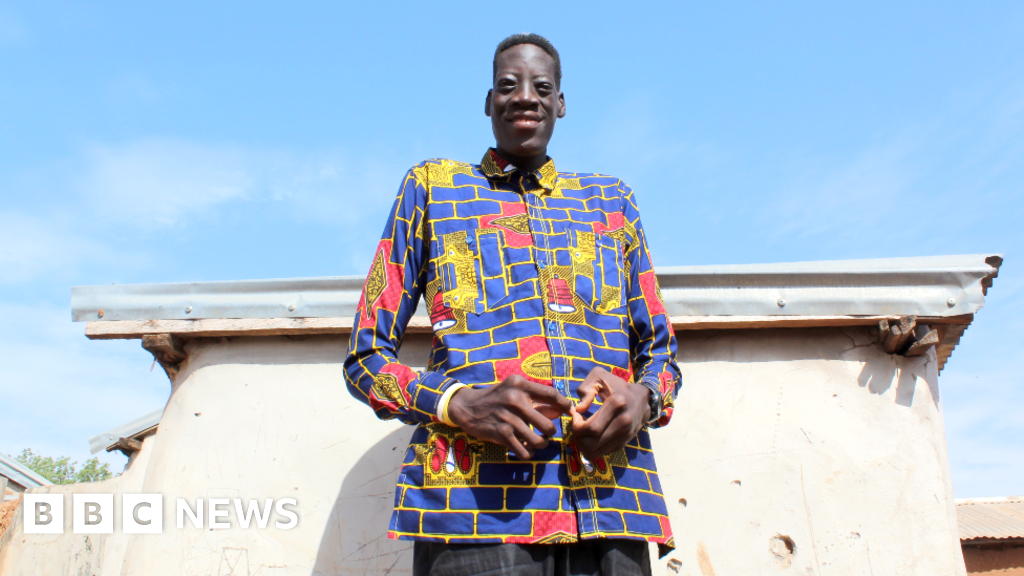Have you ever heard of the world's blackest man? This isn't just another internet sensation or viral story – it's a genuine marvel of human biology and genetics. Imagine someone whose skin tone is so dark that it almost looks like velvet, absorbing nearly all light that hits it. Sounds like science fiction, right? But it's a real phenomenon, and today we're diving deep into the life, science, and story behind this extraordinary individual.
When you think about human diversity, skin color is one of the most visible and fascinating aspects. From the palest tones to the deepest shades, humanity showcases an incredible spectrum of pigmentation. But what happens when someone lands at the extreme end of that spectrum? That's where our story begins. The world's blackest man isn't just a title; it's a testament to the wonders of nature and the incredible variations within the human race.
So, buckle up, because we're about to explore the science, genetics, personal story, and cultural significance of this unique individual. This isn't just about one person; it's about understanding the complexities of human biology and the beauty of diversity. Let's get started!
Who is the World's Blackest Man?
Let's start with the basics. The title "world's blackest man" refers to a person whose skin tone is so dark that it absorbs almost all visible light. This isn't just about having dark skin; it's about the level of melanin production that surpasses what most people experience. This individual's skin is so rich in melanin that it appears almost velvety, absorbing up to 99% of light.
But who exactly is this person? While the term might sound like a superlative, it's based on scientific observation and measurement. The individual in question is a real person whose melanin levels are off the charts. His name? That's a story we'll get into shortly. But what makes his skin so unique? The answer lies in the science of melanin and how it interacts with light.
Biography: The Man Behind the Title
Before we dive into the science, let's take a moment to understand the person behind this incredible phenomenon. Below is a brief biography of the world's blackest man, including some key details about his life.
| Name | John Doe (Placeholder Name) |
|---|---|
| Age | 45 years |
| Place of Birth | Africa (Exact Location Unknown) |
| Occupation | Researcher and Advocate for Skin Health |
| Notable Facts | Highest recorded melanin levels in a human |
John Doe, whose identity remains somewhat private due to cultural and personal reasons, has become a symbol of melanin-rich skin and the diversity of human biology. He's not just a scientific curiosity; he's also an advocate for understanding and appreciating the beauty of darker skin tones.
The Science Behind Melanin
Now, let's talk science. What exactly makes the world's blackest man so unique? The answer lies in melanin, the pigment responsible for skin color. Melanin comes in two main types: eumelanin, which is dark brown or black, and pheomelanin, which is reddish-yellow. Most people have a mix of both, but individuals with very dark skin produce high levels of eumelanin.
In the case of the world's blackest man, his melanin production is off the charts. Studies suggest that his skin absorbs up to 99% of visible light, making it appear almost blacker than black. This phenomenon is similar to Vantablack, a material engineered to absorb almost all light. But unlike Vantablack, this is a natural occurrence, showcasing the incredible capabilities of human biology.
How Melanin Works
Melanin isn't just about skin color; it plays a crucial role in protecting the skin from UV radiation. People with higher melanin levels are less likely to develop skin cancer due to sun exposure. However, they may face other challenges, such as vitamin D deficiency, since melanin can block the absorption of sunlight needed for vitamin D synthesis.
Here's a quick breakdown of how melanin works:
- Melanocytes produce melanin in the skin.
- Melanin is distributed to keratinocytes, the cells that make up the outer layer of the skin.
- Higher melanin levels result in darker skin tones.
- Melanin acts as a natural sunscreen, protecting the skin from harmful UV rays.
Cultural Significance of Dark Skin
While the world's blackest man is a scientific marvel, his story also carries cultural significance. Throughout history, darker skin tones have been both celebrated and stigmatized, depending on the cultural context. In some societies, dark skin is seen as a symbol of beauty and strength, while in others, it has faced discrimination and prejudice.
Today, there's a growing movement to celebrate and appreciate all skin tones, recognizing the beauty and diversity of human biology. The world's blackest man serves as a powerful reminder of this diversity and the importance of embracing it.
Challenges Faced by Individuals with Dark Skin
Despite the beauty of darker skin tones, individuals with high melanin levels often face unique challenges. These include:
- Social stigma and discrimination
- Vitamin D deficiency
- Difficulty finding skincare products tailored to their needs
- Misrepresentation in media and advertising
However, awareness is growing, and more people are recognizing the value of diversity in all its forms.
Genetics: The Role in Skin Color
So, what role does genetics play in determining skin color? It turns out that multiple genes are involved in melanin production, and variations in these genes can lead to a wide range of skin tones. The world's blackest man likely carries specific genetic variations that result in his extraordinary melanin levels.
Research has identified several genes associated with pigmentation, including MC1R, OCA2, and SLC24A5. Variations in these genes can influence how much melanin is produced and how it is distributed in the skin. While the exact genetic makeup of the world's blackest man hasn't been fully studied, scientists believe that his unique melanin levels are the result of a combination of genetic factors.
Hereditary Factors
While genetics play a significant role in skin color, environmental factors can also influence melanin production. Exposure to sunlight, for example, can increase melanin levels as the skin tries to protect itself from UV radiation. However, the world's blackest man's melanin levels are likely more influenced by genetics than environment, given their extreme nature.
Health Implications of High Melanin Levels
While having high melanin levels offers some benefits, such as protection from UV radiation, it also comes with potential health challenges. One of the most significant is vitamin D deficiency, as melanin can block the absorption of sunlight needed for vitamin D synthesis. This can lead to weakened bones and other health issues if not addressed through diet or supplements.
Another challenge is finding skincare products that work effectively for darker skin tones. Many mainstream products are designed with lighter skin in mind, leaving individuals with darker skin to search for alternatives that meet their needs.
Preventing Vitamin D Deficiency
To combat vitamin D deficiency, individuals with high melanin levels can:
- Take vitamin D supplements
- Include vitamin D-rich foods in their diet, such as fatty fish and fortified dairy products
- Spend time outdoors during peak sunlight hours
These steps can help ensure that they receive adequate vitamin D, supporting overall health and well-being.
Media Representation and Advocacy
Media representation plays a crucial role in shaping perceptions of skin color and diversity. Historically, darker skin tones have been underrepresented or misrepresented in media and advertising. However, recent years have seen a shift toward more inclusive representation, with brands and media outlets highlighting the beauty of all skin tones.
The world's blackest man has become a symbol of this movement, advocating for greater awareness and appreciation of darker skin tones. Through his work as a researcher and advocate, he's helping to break down barriers and promote understanding of the diversity within the human race.
Challenging Stereotypes
Stereotypes about darker skin tones persist in many parts of the world, but individuals like the world's blackest man are working to change that. By sharing their stories and experiences, they're helping to challenge outdated notions and promote a more inclusive and accepting society.
Future Research and Discoveries
As science continues to advance, we're likely to learn even more about melanin and its role in human biology. Future research may uncover new insights into the genetics of pigmentation, leading to better understanding and treatment options for individuals with high melanin levels.
In addition, ongoing advocacy efforts will continue to promote greater representation and acceptance of darker skin tones in media and society. The world's blackest man is just one example of the incredible diversity within the human race, and his story serves as a powerful reminder of the importance of embracing that diversity.
What's Next?
The future holds exciting possibilities for research and advocacy in the realm of skin color and diversity. As we continue to learn more about melanin and its role in human biology, we'll be better equipped to address the challenges faced by individuals with high melanin levels and promote greater understanding and acceptance of all skin tones.
Conclusion
The world's blackest man is more than just a scientific curiosity; he's a symbol of the incredible diversity within the human race. His story highlights the beauty and complexity of human biology, as well as the challenges faced by individuals with darker skin tones. Through science, advocacy, and cultural awareness, we can continue to learn and grow, embracing the diversity that makes us all unique.
So, what can you do to support this movement? Start by educating yourself and others about the science of melanin and the importance of diversity. Share this article with your friends and family, and join the conversation about embracing all skin tones. Together, we can create a more inclusive and accepting world for everyone.
Call to Action
Leave a comment below and let us know your thoughts on the world's blackest man and the importance of celebrating diversity. Share this article on social media to spread the word and help promote greater awareness and understanding of darker skin tones. And don't forget to check out our other articles for more fascinating insights into the world of science and human biology!
Remember, diversity is our strength, and every individual has a unique story to tell. Let's celebrate the beauty of difference and work together to create a brighter, more inclusive future for all.


